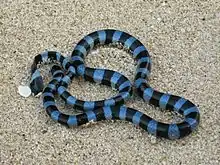Blue-lipped sea krait
The blue-lipped sea krait, blue-banded sea krait, or common sea krait (Laticauda laticaudata) is a species of venomous sea snake in the subfamily Laticaudinae, family Elapidae. It is found in the Indian and Western Pacific Oceans.[2]
| Blue-lipped sea krait | |
|---|---|
 | |
| Scientific classification | |
| Kingdom: | Animalia |
| Phylum: | Chordata |
| Class: | Reptilia |
| Order: | Squamata |
| Suborder: | Serpentes |
| Family: | Elapidae |
| Genus: | Laticauda |
| Species: | L. laticaudata |
| Binomial name | |
| Laticauda laticaudata | |
| Synonyms | |
Taxonomy
The blue-lipped sea krait was one of the many species originally described by Carl Linnaeus in his landmark 1758 10th edition of Systema Naturae, where it was given the binomial name Coluber laticaudatus.[3] There are two subspecies, Laticauda laticaudata laticaudata and Laticauda laticaudata affinis.[2]
Description
Ventral scales of this snake are large, one-third to more than one-half the width of the body; the nostrils are lateral; nasal scales are separated by internasals; 19 longitudinal rows of imbricate scales are found at midbody; no azygous prefrontal shield is present; rostral scales are undivided; ventrals number 225–243; subcaudals number 38–47 in males, females have 30–35 (ventral and subcaudal counts after Smith 1943:443). The upper lip is dark brown. Total length varies with sex: males are 910 mm (36 in), females are 1,070 mm (42 in); tail lengths are similar: 110 mm (4.3 in).[2] The 19 rows of scales and the dark brown upper lip can be used to differentiate the blue-lipped sea krait from other Laticauda species.[4]
Distribution and habitat
This species is found in the Indian and Western Pacific Oceans: Bay of Bengal (Bangladesh, East India, Andaman Islands, Sri Lanka, Myanmar, Thailand), coasts of Malay Peninsula to Indonesia, Timor-Leste, New Guinea, the Philippines, off the coasts of Fujian and Taiwan, Japan, Polynesia, Melanesia, Solomon Islands, New Caledonia, Vanuatu, Fiji, and Australia (Queensland).[2] One specimen was found in Devonport, New Zealand in 2011, however died shortly after being taken to Kelly Tarlton's Sea Life Aquarium.[4]
Special features
This snake is known to warm up in wedge-tailed shearwater burrows.[5]
References
- Kharin V. E. 1984 Revision of sea snakes of subfamily Laticaudinae Cope, 1879 sensu lato (Serpentes, Hydrophiidae). Trudy Zoologicheskogo Instituta 124: 128-139
- Lane, A.; Guinea, M.; Lobo, A. & Gatus, J. (2010). "Laticauda laticaudata". IUCN Red List of Threatened Species. 2010: e.T176771A7301306. doi:10.2305/IUCN.UK.2010-4.RLTS.T176771A7301306.en.
- Laticauda laticaudata at the Reptarium.cz Reptile Database. Accessed 8 January 2018.
- Linnaeus, Carl (1758). Systema Naturae per Regna Tria Naturae, Secundum Classes, Ordines, Genera, Species, cum Characteribus, Differentiis, Synonymis, Locis (in Latin). Vol. I (10th revised ed.). Holmiae: (Laurentii Salvii). p. 222 – via The Internet Archive.
- Gill, B.J.; Whitaker, A.H. (2014). "Records of sea-kraits (Serpentes: Laticaudidae: Laticauda) in New Zealand". Records of the Auckland Museum. 49: 39–42. ISSN 1174-9202.
- Brischoux, F.; Bonnet, X.; Shine, R. (2009). "Kleptothermy: an additional category of thermoregulation, and a possible example in sea kraits (Laticauda laticaudata, Serpentes)". Biology Letters. 5 (6): 729–731. doi:10.1098/rsbl.2009.0550. PMC 2828009. PMID 19656862.
External links
| Wikimedia Commons has media related to Laticauda laticaudata. |
- Hans Breuer & William Christopher Murphy (2009–2010). "Laticauda laticaudata". Snakes of Taiwan. Retrieved 7 October 2012..
- Photos of Blue-lipped sea krait on Sealife Collection

.jpg.webp)